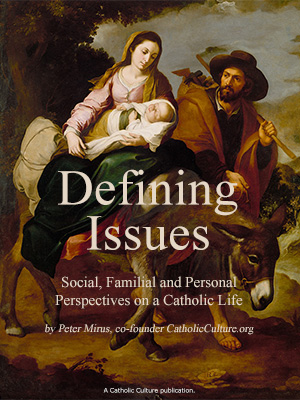USCCB meeting: plans for Year of Faith announced; 10-year report on abuse scandal issued
June 14, 2012
Free eBook:

|
| Free eBook: Defining Issues |
On the opening day of the spring meeting of the United States Conference of Catholic Bishops, the chairman of the National Review Board (NRB) discussed a new 10-year progress report on addressing the clerical abuse scandal.
“Ten years later, there has been striking improvement in the Church’s response to and treatment of victims,” said Al Notzon III, who served as executive director of the Alamo Area Council of Governments from 1971 to 2007 before Archbishop Timothy Dolan named him chairman of the National Review Board in February 2011. The board is a consultative body established in 2002 that collaborates with the US bishops in their efforts to address clerical sexual abuse.
“Children are safer now because of the creation of safe environments and action has been taken to permanently remove offenders from ministry,” Notzon added. “Yet, much work still needs to be done.”
The report, from which Notzon quoted extensively in his remarks to the bishops, stated:
In 2004, the Nature and Scope Study reported 4,392 clerics had allegations made against them. Since then, an additional 1,723 clerics have had credible allegations made against them. While many of the offenders have died, 253 were reported as deceased in the 2011 Annual Report, the Church should take a special look at those men who have been removed from public ministry. Many dioceses/eparchies have developed “safety plans” for those clerics removed from ministry but not from the clerical state. These safety plans are critical to the continued protection of children. Assignment to a life of prayer and penance must be taken seriously.
“A serious concern of the NRB is complacency or Charter drift – that is, thinking 10 years of action is enough and programs and vigilance can be taken for granted or worse, watered down. While the current trend shows a decrease in clergy sexual abuse,” the report concluded, referring to the 2002 US bishops’ charter on the abuse scandal. “We must never let our guard down. Now is not the time to drift away from the moral requirements of the Charter and the legal requirements of reporting. Children must be protected. Bishops must continue to work toward restoring the trust of the faithful. Only when bishops are seen as following through on their promise to protect and pledge to heal, will the faithful begin to trust them to take care of their most precious gift – their children.”
In its recommendations to the bishops, the National Review Board concluded:
It is incumbent upon the bishops to ensure the routine practices included in the Five Principles adopted by the bishops in 1992, as stated in the Charter and codified in the Essential Norms, are followed. These practices include: 1) respond promptly to all allegations of abuse, 2) promptly relieve the alleged offender of ministerial duties if the allegation is supported by sufficient evidence, 3) comply with obligations of civil law, 4) reach out to victims and families and 5) deal as openly as possible with members of community.
Later in the day, Bishop David Ricken of Green Bay, chairman of the USCCB Committee on Evangelization and Catechesis, discussed the USCCB’s plans to promote the Year of Faith in US dioceses. The Year, announced by Pope Benedict in his October 2011 apostolic letter Porta Fidei, commemorates the fiftieth anniversary of the opening of the Second Vatican Council and the twentieth anniversary of the promulgation of the Catechism of the Catholic Church.
Bishop Ricken encouraged dioceses nationwide to consider implementing the Archdiocese of Washington’s “The Light is on for You” campaign, in which all churches are open for confession at the same day and time during Lent. Bishop Ricken announced a searchable online version of the Catechism and stated that particular emphasis would be placed on January 22 (the anniversary of the Supreme Court decision legalizing abortion) and March 25 (the Solemnity of the Annunciation) to spread the teaching of the Church on the Gospel of Life.
“The central image of the Year of Faith is the ‘door of faith’ based on Acts of the Apostles,” said Bishop Ricken. “The ‘door of faith’ is opened at one’s baptism, but during this year we are called to open it again, walk though it and rediscover and renew our relationship with Christ and his Church.”
For all current news, visit our News home page.
Further information:
- Bishops Plan Materials, Events, Social Media Outreach For Year Of Faith (USCCB)
- National Review Board Reports On 10 Years After Charter (USCCB)
- A Ten Year Progress Report (National Review Board, USCCB)
- National Review Board Recommendations – 2012 June (USCCB)
- Catechism of the Catholic Church: new searchable online version (USCCB)
- Video archives of June meeting (USCCB)
All comments are moderated. To lighten our editing burden, only current donors are allowed to Sound Off. If you are a current donor, log in to see the comment form; otherwise please support our work, and Sound Off!







